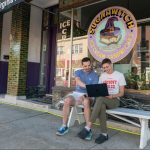Commentary is a regular UMSL Daily column written by members of the UMSL community.
The fragmentation of police services is a problem inherent in the organization of many communities across the country. St. Louis is no different, as there are a multitude of jurisdictions – many of which have their own police departments. This fragmentation has the potential to reduce the ability of law enforcement agencies to collectively combat crime and disorder and provide effective community services.
Having said this, the St. Louis Metropolitan Police Department and the St. Louis County Police Department have made great strides in coordinating police services. Of particular import are the efforts of these departments to make use of crime mapping.
Did you know that you can find out about crimes occurring in different areas of the city and county using the mapping tools provided by these departments? You can. Just direct your web browser to slmpd.org/crime_mapping.html if you live in the city or to maps.stlouisco.com/police/index.html if you live in St. Louis County. Despite the differences in software used, each of these sites allows you to see specific crime incidents throughout the area.
Some may ask why crime mapping is needed. After all, many of us are aware that certain communities have higher crime rates than others, and many also are aware of the most “crime-prone” communities in the region. But crime mapping can be an important tool for the administration of police services.
For example, if a “crime-outbreak” occurs in a specific community, police can enhance their presence in that community to stem the crime tide. Similarly, if there is an outbreak of certain types of crime – say gun violence – police can increase their presence in that area to ramp up prevention and enforcement efforts.
These are important as research has consistently showed that targeted patrol and enforcement for certain crimes can have an important effect in reducing these problems. Equally important, focused enforcement has been found to reduce crime generally in areas with enhanced police presence without crime being displaced to other communities. The beneficial effects of targeted enforcement stand in stark contrast to general patrol, which has not been found to have the same benefits.
The SLMPD and SLCPD should be commended for their innovative use of crime mapping software. There is considerable room for improvement, though.
While the maps provided by the SLMPD are comprehensive across all areas of the city, the same is not true of the county. This appears to be vestiges of the fragmented nature of the St. Louis County communities more than a limitation with the SLCPD efforts. Many of the smaller municipalities choose not to release their incident reports. This is unfortunate because it reduces the likelihood that patrol efforts will have an appreciable effect in reducing the crime problems in the St. Louis region.
Due to the effects of crime mapping as a tool for effective law enforcement, all jurisdictions are encouraged to consider releasing their incident reports to the county in a timely fashion. This will likely lead to more effective law enforcement efforts that make the St. Louis region safer.
Terrance J. Taylor is an assistant professor of criminology and criminal justice at the University of Missouri–St. Louis.















